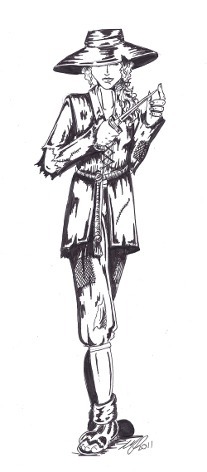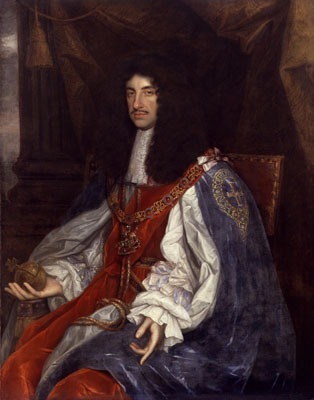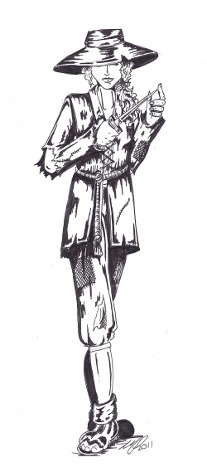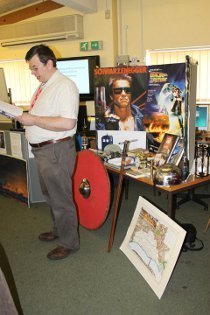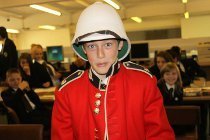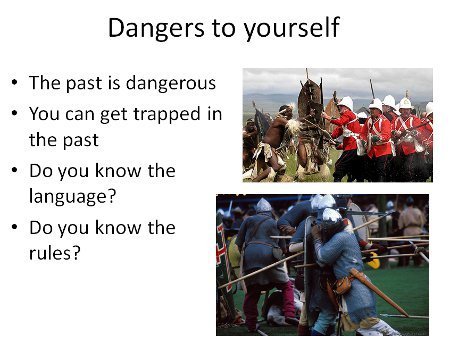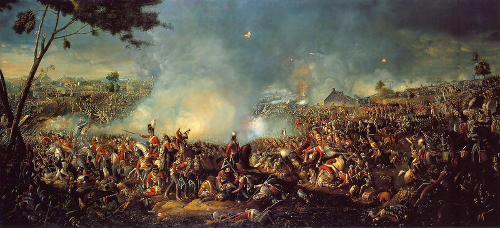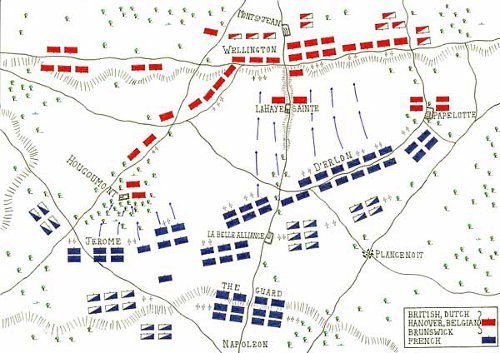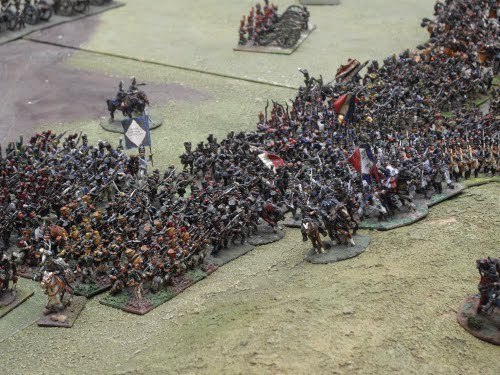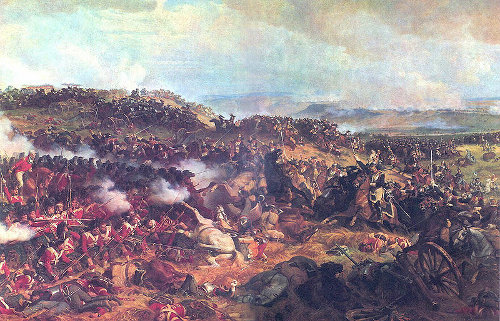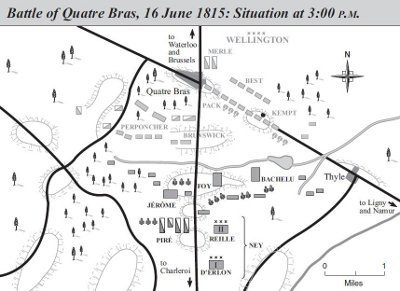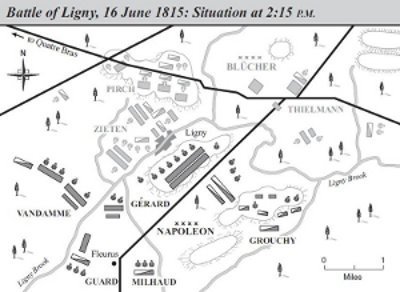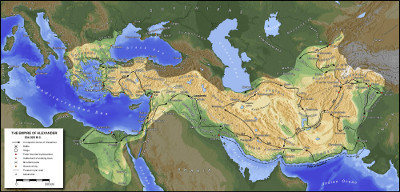Richard Denning's Blog, page 19
July 7, 2011
The 17th Century in 26 Words
Like all people in all ages, the inhabitants of London in 1666 had their own slang and language. Some are words we still used to day. Some are very alien and reflect a long lost world, yet a world inhabited with people like you and I. They were full of the same fears, desires, longings and weaknesses each of us have and use these words to express them. If these phrases seem off just consider for the moment how many words we bandy around today will be in common use in three or four hundred years.
I can recommend a good little book for those interested in more research:
Here are 26 words in common use in the 17th century.
A thirsty man in 1666 would more likely drink beer, wine or coffee but just as today if a clean source would be found might enjoy Adam's Ale – water.
A stupid fellow of little wit might be called a blunderbuss.
Hens laid cackling farts or eggs!
If you decided to beat the living daylights out of someone you dumbfounded them. Interesting how that has lingered but has a different meaning of to get the better of or to confuse someone.
Another name for an oak tree was English Cane.
If you were hungry you might ask for Florentine - a dish made from minced meat, currants, spice and eggs.
If someone had good eyesight you might say they had rum glaziers.
A Housewife was a hussy – which eventually became the insult we have today.
An implacable enemy was an inveterate.
If you earned a guinea you were given a job .
If you wore breeches you had on a pair of kicks
Another name for a chamber pot was a looking glass.

To kill was to mill them. Thus to mill a grunter was to kill a pig.
Nutcrackers was a name for the pillory in which a thief might be placed as punishment.
A rick man was an oak.
If you stabbed someone with your porker you has just attacked them with a sword.
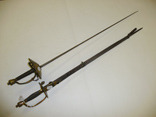
If you could not pay your bills you were sent to the Quod - debtors jail or Newgate Prison.
If you took a coach journey you were riding on a Rattler. Presumably with all the bouncing around on it or in it.
If the city watch were after you you would Scowre away – scamper or scuttle – run very fast to evade capture.
A richman might employ a Taleteller to tell them a bed time story and help them get to sleep
Stockings were called Vampers

A thief operating out of a boat and attacking boats and ferries on the Thames was a water-pad
Led astray by a something that turned out to be a red herring? In 17th century you had been fooled by a Yarmouth-capon.
If the king was hungry he might summon a Yeoman of the Mouth - a servant from the pantry!
A zany – was a name for jester.
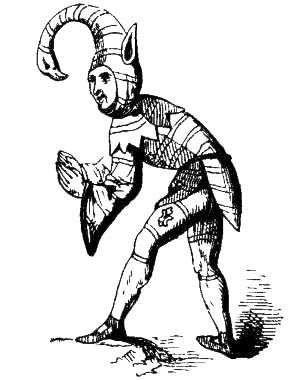
This article is one of a series connected with the release in August of the new paperback of The Last Seal my historical fantasy set during the Great Fire of 1666.
Check out the book's Facebook page here:http://www.facebook.com/TheLastSeal
Read part of the book here: http://www.richarddenning.co.uk/thelastseal.html
July 6, 2011
Freya – scratching a living in London 1666
Character Sketch from The Last Seal. Sketch is by Gill Pearce of Hellion's Art
Summary: Cheerful, cheeky but initially selfish young thief who must decide whether to risk her life to save her city.
More info: Orphaned during the plague, Freya scrapes a living thieving and pick-pocketing. One day she is caught red handed and shifts the blame on the schoolboy Ben and with him evaded capture. This chance meeting throws her into an encounter with rival secret societies. One of them wishes to free a powerful ancient demon imprisoned under the city by their rivals.
Initially she refuses to take sides unless she gains a reward but her decision on which side to back and whether to take risks to protect her beloved London is pivotal in the ensuing struggle.
Richard's note: Freya is probably my favourite character The Last Seal.
Check out the book's Facebook page here:http://www.facebook.com/TheLastSeal
Read part of the book here: http://www.richarddenning.co.uk/thelastseal.html


July 3, 2011
Gunpowder and Sorcery in 1666
Why the Great Fire is an ideal setting for a historical fantasy
by Richard Denning
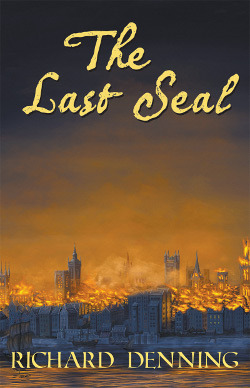
London in the year 1666 was a power keg ready to explode – and I am not just talking about the possibility of the Great Fire which over 5 days in September destroyed for ever the medieval city. There were other elements fuelling fiery emotions that would boil over during and after the fire. England had been through a dramatic two or three decades politically. They had fought a civil war and executed a king and although Charles I's son, King Charles II was back on the throne there had been those willing to rise up against him. There was still religious strife and distrust and a great fear of a catholic plot. This was a time when people believed in magic and witchcraft and omens and superstition was rife. Finally England was at war with both France and Holland.
This stew of conflicting emotions was the stuff that would generate immense paranoia when the time came. Add in a bit of sorcery, a demon or two and the basis of a historical fantasy is born. Our world … our history … but a little different. This is the world of The Last Seal.
This summer a new paperback of The Last Seal is coming out (as well as a kindle version) and I am going to be sending the book on a blog tour during the anniversary of the real Great Fire of London and afterwards. In the mean time I am going to be doing a number of Blogs about the 17th century world.
Here are some things I will look at:
A decade a week through the 17th century
In a weekly post through to the start of the blog tour I will take a brief look at each decade from 1600 to 1666. Who was king? What were the issues of the day? How did the Civil war happen? How did a king get executed and how did his son finally return in triumph. What were the first years of Charles II's reign like. A look at the plague and the fire and the foreign wars.
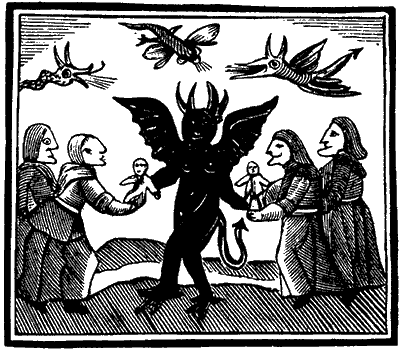
A world of magic, superstition, plots and strife
Once a week over the summer I will look at the such things as what people believed about sorcery and witchcraft in the 17th century, what omens and strange events captured the public imagination. I will also show how such a world is an ideal setting for fantasy and talk a bit about how I chose to do magic and demons my fictional world. We will also have a look around London in 1666 and see what were the places of interest in a city about to burn.
A character a week
There are 8 main characters in The Last Seal: Ben the schoolboy, Freya the thief, Tobias the vengeful physician, Gabriel the scholar of arcane secrets, Artemis the cavalier, Mathias the zealot, Gymer the spy-master and Dantalion the demon. With a sketch from artist Gillian Pearce and a short bio I will introduce them all.
I hope you enjoy a little tour through the historical world of the 17th century and the fantastical other-world of The Last Seal.
July 2, 2011
An Idiot's Guide to the Anglo Saxons
by Richard Denning
Overview: Who were the Anglo Saxons
The Anglo Saxon Era lasted from about 449 to 1066. Much of the England we know today dates back to these years. Our language, our places names, many of our laws and traditions owe much to this period.
If you ask the question: Who were the Anglo Saxons? The answer is WE ARE!
Did you know?
The name Anglo-Saxon comes from two of the tribes who invaded Britain – The Angles and the Saxons.
The Anglo Saxon Invasion
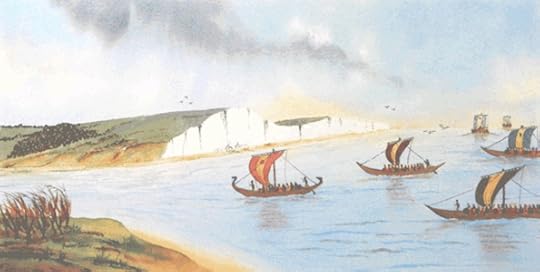
AD 449: In their days Hengest and Horsa, invited by Wurtgern, king of the Britons to his assistance,
landed in Britain in a place that is called Ipwinesfleet; first of all to support the Britons, but they afterwards fought against them.
From AD 70 until around AD 400 most of Britain was ruled from Rome as the Province of Britannia. As pressures from outside the empire, and weaknesses and corruption from inside grew Rome abandoned Britain. The result was that the Romano-British (who would one day become the Welsh) were left to defend themselves from Picts and Irish and Germanic Raiders.
The Anglo-Saxon Chronicle and other records suggest that after Rome officially told the former province of Britannia to look to its own defences in about 416 AD that the British invited in Germanic mercenaries to help defend Britain. Probably German tribes were already migrating to Britain in the Roman period as the Romans used Germans in their Legions but in 449 there is this entry. The British King Vortigern invited Hengest and Horsa to come to Britain.
Hengest and Horsa were followed by many other warlords and their followers. At first they fought for the British and settled peacefully along the eastern and Southern coasts. Eventually several things may have occurred:
1. Its possible that the British refused to pay the mercenaries or to give them promised land.
2. The numbers of Anglo-Saxons grew year on year and in time their immigration became a big problem bringing them into conflict with the Romano-British Population.
3. Ambitious Warlords amongst the newcomers saw an opportunity to carve out a kingdom and launched attacks.
4.Pressures from movement of Eastern Europeans westwards pushed the Angles and Saxons off their own homelands encouraging them to look elsewhere for land.
However it happened by the late 5th centuries colonies and settlements of many tens to hundreds of thousands of Anglo Saxons were established. The stage was set for several centuries of conflict that would see the Anglo-Saxons occupy most of what is today England.
The invading Tribes
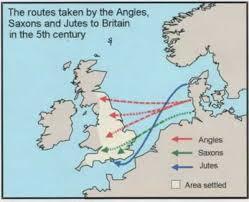
There were a number of Tribes who migrated to Britain:
The Angles – from Denmark settled along the North and East – in Northumbria and East Anglia.
The Saxons – from Northern Germany settled Essex, Sussex, Kent and other South Eastern parts.
The Jutes from the north of Denmark landed along the south coast especially around Hampshire.
There were other tribes who came such as the Frisians from Holland and the Franks (who also invaded and gave their name to France).
These tribes were divided and fought as much against each other as against the Romano-British inhabitants. Indeed in the early period there were several times when the British and allies launched huge counter attacks such as at Catraeth in circa AD 597 and Degsastan in AD 603. The Anglo-Saxons weathered these storms and by the mid 7th Century had established a number of strong Kingdoms.
The Heptarchy
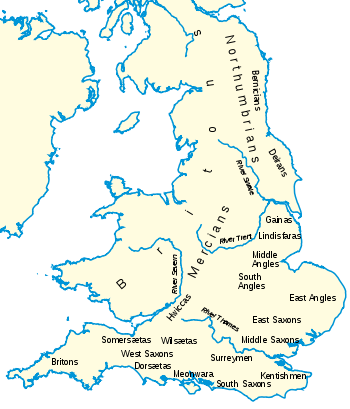
After the first few centuries the myriad of colonies and settlements had merged into what is usually identified as seven more permanent kingdoms. These were the kingdoms of
Northumbria, Mercia, East Anglia, Essex, Kent, Sussex and Wessex. The Roman-British were now pushed west into Wales, Cornwall, the Scotish Borders, Lancashire and Cumbria. This process of amalgamation into these larger kingdoms was ongoing but by about AD 800 this is what England looked like:
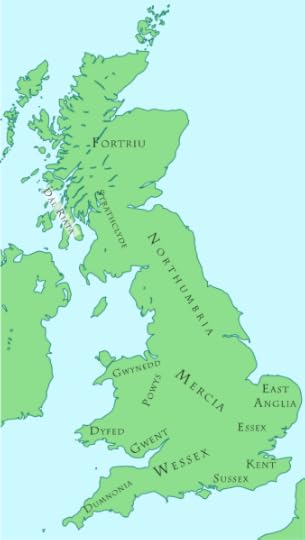
The Overlords – or Imperators
From about AD 600 onwards several of the Chroniclers of the time began to talk of overlords or Imperators who recalling the power of Roman Emperors exerted influence BEYOND their own borders. In the late sixth century the King of Kent was a prominent lord in the south; in the seventh century the rulers of Northumbria and Wessex were powerful; in the eighth century Mercia achieved hegemony over the other surviving kingdoms. These Imperators give us a hint of the struggle towards the possibility of a single King and a single Kingdom – England. But just as the move towards a unified England are going on the we enter the era of a great threat to England – the Vikings.
The Viking Invasions
AD 787 to 1066

A.D. 787 . This year King Bertric took Edburga the daughter of
Offa to wife. And in his days came first three ships of the
Northmen from the land of robbers. The reve then rode
thereto, and would drive them to the king's town; for he knew not
what they were; and there was he slain. These were the first
ships of the Danish men that sought the land of the English
nation.
From the late 8th century and in particular the 9th,10th and 11th Centuries the Vikings or Danes began raiding Britain. At first the Vikings plundered and killed but went away again. In time, however, they stayed and settled the east coast of Northumbria and East Anglia. They destroyed the Kingdoms of Northumbria, East Anglia, Essex and Mercia and almost overran Wessex. But a young king called Alfred defeated them at Edington, Wiltshire, in 878 and earned himself the name "The Great". He made a peace with the Vikings and saved England but the peace deal granted the VIkings a kingdom called Danelaw which included their possession of Jorvik (York) and so the Danes had gained a solid foothold in England.
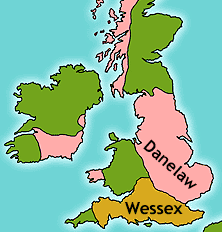
The Vikings would continue to be a threat right up to 1066 when they fought Harold at Stamford Bridge. Indeed a Viking King – Canute and his sons sat on the English throne in the 11th century and ruled over a unified England at last – Vikings and English as one people.
This unified England carried on under the last Anglo Saxon Kings – Edward and Harold.
Finally then we have one land – one England. Then came 1066.
1066 – The end
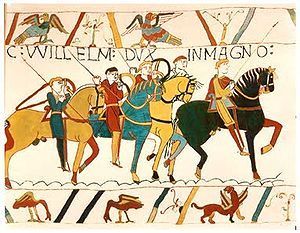
King Edward the Confessor made one major error. Having failed to produce an heir he made a mess of establishing the sucession. He led William of Normandy into a belief that he was the heir – a belief given weight when William obliged the obvious English candidate – the powerful Earl Harold – to swear alliegance to him. When Edward died and the Witan elected Harold as king the scene was set for the Norman Invasion.
The Norman conquest of England began on 28 September 1066 with the invasion of England by William, Duke of Normandy, who became known as William the Conqueror after his victory at the Battle of Hastings on 14 October 1066, defeating the then king Harold II of England. Harold's army was badly depleted in the English victory at the Battle of Stamford Bridge in Northern England on 25 September 1066 over the army of King Harald III of Norway. By early 1071, William had secured control of most of England, although rebellions and resistance continued to approximately 1088.
The Aftermath – did the Anglo-Saxons Survive?
The Norman conquest destroyed the Anglo-Saxon monarchy and a large part of the noble lines as incoming Normans became the lords of the land. That said the blood line of the Anglo-Saxon kings re-emerged later on because of marriages of various daughters and sons of former kings into for example the Scotish Royal line. So in time the Kings of England would one again have Anglo-Saxon ancestors.
The Normans became the ruling class but probably 95% of the population was English. Although for a time the language used in court was French and that in legal documents latin eventually English reemerges as the dominant language.
Some place names come from the Norman period but most come from Anglo-Saxon and Viking origins. Many of the laws we have have origins in the Anglo-Saxon common law.
So we can conclude that the Anglo-Saxon period did not really end in 1066. If you are English or of English decent YOU ARE an Anglo-Saxon.
This period – and in particular the early years of the Anglo-Saxon settlement – is of great interest to me. Please take a look at my novel set in the late 6th Century The Amber Treasure. You can read the first third of the book on my site.

June 28, 2011
How authors can Market books via visits to schools
Experiences of organising visits to schools to do author talks.
by Richard Denning
For an author the hardest part of the process of writing and publishing books is promotion and marketing. Getting your book read by people involves getting it IN FRONT of people. The hard grind of achieving that falls to the author not the publisher (and in many cases they are one and the same in any event).
One opportunity worth exploring is giving talks at schools. All schools are keen to bring in a variety of visitors to talk about all subjects and topics and therefore an author should think hard about whether they or their books could be of interest to the school.
1)Working out what you could talk about
Whether your book is fiction or non fiction ask yourself:
Is the book aimed at or appropriate for Primary or Secondary age children?
Is the subject matter one that fits with the schools curriculum? Here in the UK there is a National Curriculum that it is worth checking over to see what is actually taught at schools. Most other countries will have something similar.
Are you an expert on your subject matter. The answer may well be yes even if you don't think it. If you have researched a particular historical period, an area of science or a specific location the chances are that you know a lot about that – a lot more than most others anyway.
Are there other aspects of the world of writing planning a book that could be used in a talk?
Is there something about publishing that you can talk about. Actually getting a book published -whether mainstream or self published or Print on Demand involves many steps that has given you an experience that most people do not understand and that could be valuable.
Sit down and write out the sorts of topics that you could cover. So in my case I write Historical Fiction and also Young Adult Science fiction involving time travel to different periods. This means there are specific historical periods I know a lot about. I have also explored the physics of Time Travel as well as seen an unhealthy number of films and read too many books about it. I have developed my own method of researching, plotting and writing that I can discuss. I am self published so I have experiences of that process and because like all authors I have approached mainstream agents and publishers I know something of the stages of making submissions.
I then summarised several of these areas into a brief description:
Time Travel sound like fun until you try it The fascination of time travel and why it could be more dangerous than you think! A rattle through Time Travel in book and movie, the physics of Time Travel and its dangers. Includes readings from Tomorrow's Guardian. Ideal for Years 6 to 8.
The Great Fire of London 1666 By Permission of Heaven! A talk about The Great Fire of London – its causes, extent and the fallout from it. Includes readings from Tomorrow's Guardian and/ or The Last Seal and use of video, maps and my Board Game to illustrate. Can be pitched at Primary school or adapted for secondary schools.
Introduction to writing Historical Fiction Making the past believable. Looking at writing historical novels. Inspiration for ideas, researching the subject, plots and people, making it vibrant and alive. Where to go next. This is intended for Year 6 Primary school or Secondary schools.
The ins and outs of getting published - by a self published author "I would be grateful if you would consider my novel." So you have written a book – where to go next. Researching the market, spotting the next big thing. Writing a proposal. Agents, publishers, Print on Demand, Small press and self publishing. This is intended for secondary schools and possibly Year 6 primary schools.
The Zulu war of 1879 - Great Courage and great fools! About the invasion of Zulu land in 1879 – the mistakes and the amazing heroism on both sides.
From those outlines I then planned out each talk which included estimates of timing of each bit. No plan will survive intact on contact with school children but you need A PLAN and then the ability to adapt it. I aimed for talks that would last about 60 to 90 minutes but could be shortened if needed. See more later.
2)Approaching Schools
The next thing I did was to set up a page about the visits on my website so that the schools could see what was on offer. On this website I lay out my expectations. So I specify the talks that I will do. I say something about age groups and duration. I give some idea about the sorts of activities that would go on. Then I say what I would expect in return. Now this is a delicate matter. At my stage I am very keen to get more readers and so I will go to some lengths to facilitate a visit. All I ask for is that the school buy 1 copy of each of my 4 titles at £6 each – which is not exactly a vast outlay. In the case of primary schools only2 of my titles are really appropriate so I only ask that they obtain those 2. Schools do have a budget for this sort of thing and that kind of outlay is really within their scope. You have to consider whether to charge travel costs. I say on my website that I will charge 25p a mile but will actually wave this if the school is local.
I don't charge any form of appearance fee. My view is that I want to get my books in front of as many people as possible so why put obstacles in the way. Furthermore I am an unknown author beyond a small readership so who would pay me?
You can contact schools:
In person by going in. This is difficult as most schools are not keen on drop in visits but it would be a way of getting material to them. It is easier if you have contacts in the school.
By mail – but a physical mail shot to lots of schools will get expensive.
Email. School do list contact email addresses and there are sites that list schools in each area and even ones that have lists of contact emails BUT these can be out of date quickly.
By word of mouth. Of you get a good visit, ask the school to tell other schools.
When you have contact with a school I suggest you spell out in detail:
The exact time and date of the visit
The age group and group sizes you will be talking to
What environment will you be talking in – the school hall, library or class room etc.
Who is the supervising person. You should never be left alone with children.
The time length of the sessions
The subject matter you are being asked to talk about
An agreement on terms of any payment, expenses , book purchases etc
Can you park the car, will they feed you!
3) The Talk
Attention spans are getting shorter we are told. Therefore it is important to grab the audience's attention and keep them engaged. As I have progressed through the talks I have done so far I have added in MORE interaction and more times when the children can get up, come forward and do something.
I take a lot of props along – such as old uniforms, weapons, armour posters from movies and books. The children should be encouraged to pick them up, talk about them and try clothing on.
I incorporate activities. FOR EG I hand out lots of post cards of histocal periods and ask them to choose one to wrire about. When exploring Time Travel I get them to play out some paradoxes and experiments and I am always on the look out for more to add in.
I build in video clips from movies and cartoons. I use power point to illustrate talks as well.
The key is to break it up. Have lots of different things going on. Get the children out to take part and involve them in discussion. Challenge them "Do you think Time Travel is possible?" "No — why not?"
4)The Promotional bit
I take along book marks and postcards and posters and liberally hand these out. I make sure that I do a reading from a book at least once in a talk – even if a brief one. I mention my website and blog and suggest if they want to find out more they go there. I DON'T try and sell the books to the children BUT I of course will do so if they ask. You wont sell many books directly at school most likely BUT you hope that some will be picked up afterwards and if the school can buy a couple then that is a result already.
I take a camera and ask one of the children to take some photos. I ask permission IN ADVANCE about this and also ask the school to check permissions for each child's image to be taken (most schools will get parents to sign these at the start of the year).
5)Afterwards
I email the school within a day or two, thank them for having me, ask for feedback and permission to use images and ideally a quote I can use on the website. I offer to go back if they want another visit.
You can see my visits page on my site here:
http://www.richarddenning.co.uk/visits.html
For more about my time travel series go here:
http://www.richarddenning.co.uk/tomguard.html
For more about my historical fiction series go here:
http://www.richarddenning.co.uk/theambertreasure.html
For more about the Great Fire Historical Fantasy go here:
http://www.richarddenning.co.uk/thelastseal.html

June 25, 2011
Time Travel – What could possibly go wrong?
A look at some of the problems and dangers of Time Travel.
by Richard Denning
Is Time Travel Possible? Well that is a subject of an article on its own but lets accept for the moment that it is possible and that one day people could travel through time. If they could do this what are the dangers?

Straight forward and very practical dangers
To me the most obvious problem with travelling through time is the sorts of places you would end up. Can you speak the language? Do you know the laws? We find travelling to strange countries at times confusing and it is very easy to get some custom wrong. This would be even more so in the past. So simply getting by on a day to day basis would be hard enough.
The Past is also a dangerous place with a large part of human existence occupied by conflict. There are other dangers of course. What if you appeared right in the middle of the Great Fire of London:
————————————————————————————
At that moment, fire surged up the stairs towards the two Walkers. Septimus cried out, then stumbled and fell hard onto the wooden floor, pulling Tom with him. Weakened by the fire from below, the wooden landing collapsed and they both fell through the hole.
Tom managed to catch hold of a ceiling beam as he fell, leaving him dangling down into the room below. Septimus landed with a crash on top of the baker's table in the middle of the room on the ground floor. Despite the inferno all around it the table was as yet intact. It was, however, smouldering.
"Septimus!" Tom yelled, but his friend did not respond and appeared to be out cold on the table below. The flames advanced on them both from all sides. Tom tried to Walk, but could not concentrate enough to focus on the Flow of Time. With a growing sense of despair, he felt the heat rise. His hair crackled and his shoes started to smoulder. Below him, one leg of the baker's table caught fire. The table creaked then, with a snap, the leg gave way and the whole thing collapsed, throwing Septimus' limp form onto the floor.
There was another roar and from the ends of the room two huge waves of fire swept towards them; at any moment it would surround them. This was it, Tom thought. Who would have reckoned he would die in the Great Fire of London? He braced himself, the muscles in his arm screaming at him to let go of the beam.
From Tomorrow's Guardian
————————————————————————————
Changing History
How fragile is time? How resistant to change is it. In Chaos theory there is a concept called the butterfly effect that suggests that even tiny things – like a butterfly flapping its wings can change events on a large scale. Take this example:
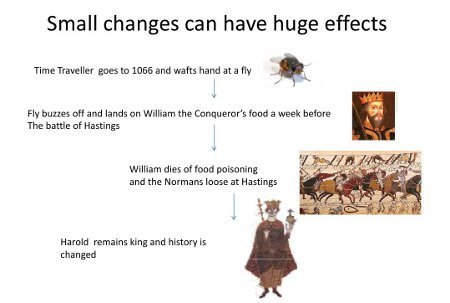
Other theories suggest that you CANT change anything and that history is the way it is and as it played out the way it did any attempts to change it will fail. Even if small changes are possible the big picture would remain the same. So William might get ill but recover and still get his victory or if he died his son would take over etc.
This is when it really gets weird – Paradoxes.
When you start messing about with time strange possibilities emerge. So for example lets look at the Grandfather Paradox. You invent a time machine and go back in time. You kill your grandad. If your granddad died YOU were never born. So who was it that just went back and killed their granddad?
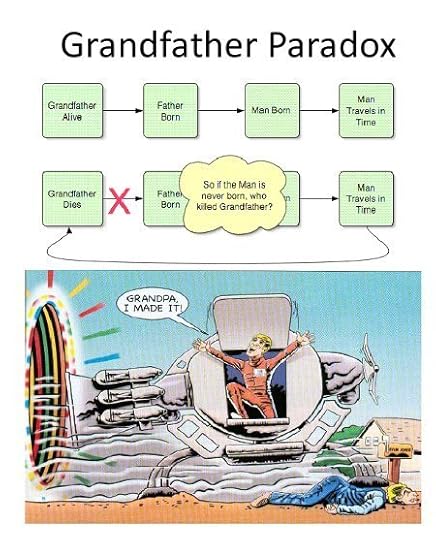 One way out of this dilemma is to assume that the universe, laws of physics or whatever WONT allow this to happen. Your granddad will somehow survive. Say you sent a bomb to him in the past – the bomb does not go off.
One way out of this dilemma is to assume that the universe, laws of physics or whatever WONT allow this to happen. Your granddad will somehow survive. Say you sent a bomb to him in the past – the bomb does not go off.
 Another way out of the problem is that when you change the past a new ALTERNATE future is created. This is the Multiple World Theory of Quantum Physics. So you travel back from Timeline A, change history and your granddad died and you live your life out in timeline B – a world in which you were never born.
Another way out of the problem is that when you change the past a new ALTERNATE future is created. This is the Multiple World Theory of Quantum Physics. So you travel back from Timeline A, change history and your granddad died and you live your life out in timeline B – a world in which you were never born.
Where did that spoon come from
This one is even stranger. Lets say when you were a child a man visited you and gave you a spoon. You loved that spoon and took it everywhere. When you were an old man you invent a time machine and decide to go back in time and see your parents. You naturally take the spoon with you. When you see your family you meet yourself as a child and GIVE yourself the spoon.
Question? Where did the spoon first come from?
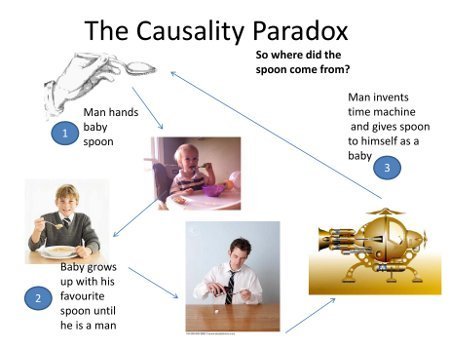 Answers on a post card please…
Answers on a post card please…
So you can see that time travel raises fun and very weird possibilities. This is of course why it is the subject of so many books, movies and TV series.
This is a subject that has long fascinated me and all these paradoxes and dangers (as well as the opportunities of time travel) are explored in my time travel adventure story Tomorrow's Guardian.
————————————————————————————
"Well, what's going on? Did you do this? I trusted you. Was this all a trick to get me away from here so your friends could do this?" Tom demanded.
The Welshman shook his head. "I promise I didn't do anything of the sort," he said, but Tom thought he had a guilty look on his face.
"Well who did? Who burnt the house down? Can you tell me anything, Septimus? Can you tell me if my parents are alright?"
Letting go of Tom, Septimus reached into his trouser pocket. He brought out a small device that looked a little like an iPod. There was the sound of beeping as he pressed a few buttons. He then held the item up at arm's length and swept it around in a half circle. After pressing his buttons again he looked up at Tom, but said nothing.
"Well? What's that?" Tom asked, knowing he sounded rude, but not caring.
"We call it a Time Sniffer. Probably got a more technical name but I don't know it. It can detect deviations from the time line."
"Eh?"
"If someone does something to alter history this tells me it has happened," the man explained.
"Alter history: you mean this might have happened in the past?" asked Tom, thinking it would explain why the house was cold as if the fire had happened long ago. He swallowed, tried and failed to keep the anxiety out of his voice, "Well, has anyone?"
Septimus nodded, "I'm sorry, but yes. I am confused though. This thing is giving me mixed messages. Something more complex has gone on than a simple change. This device detects two types of change. It feels the change in a location. Someone has changed history relating to this spot. But also it detects change relating to people." He suddenly stared down at the boy. "Of course, that's it! It feels it on you. Some change to do with you. It's a strong signal and I think …" He stopped speaking and dropped the device.
"Oh my God! It can't be, can it?" he said, staring at the device as it lay on the ground and then leaning over and picking it up again. He grimaced as he took in the symbols on the screen, then looking up he stared at Tom.
"What? Septimus, what is it?" Tom thought the Welshman seemed a little afraid of him and it scared him.
"Something very bad has happened here. This thing says the fire occurred twelve or so years ago and that your parents died in it. You are a paradox, my boy: you don't exist. You were never born!"
————————————————————————————
Tomorrow's Guardian is published by Mercia Books and is available in paperback and e-book from:
http://www.merciabooks.co.uk/books.html
http://www.amazon.co.uk/dp/0956483569
http://www.amazon.com/dp/0956483569

June 21, 2011
Selling e-books via Goodreads

If you are already selling ebooks via Kindle and Smashwords you may be interested that you can sell your e-books via Goodreads.
Goodreads has been called 'Facebook for book readers'. It is a large community of people who read, write and review books. As an author – whether self, indie, Print on demand or Mainstream published you need to be on there and to create a profile. Make sure all your books are listed.
When you set up an account you can invite Facebook Friends to join as well. Just like Facebook you can reach out and make new friends. Ther are many groups and forums just like with Facebook so if you are into Sci-Fi for instance you can join any of several dozen groups. You can then 'join the conversation' on any topic you wish – generally book related.
When reviewers give your book a review many will automatically post here but if not you can send them a link to your book's listing at Goodreads.
E-books
As an author you can apply for Librarian status which means you can edit book listing, add images and other editions etc. You have to agree to be honest and accurate in all you do. Once you have obtained Librarianship you can then upload e-books.
Your options are to upload a pdf which can be read FOR FREE by all members or upload a e-Pub file. ePub files need to be created from your original word document. See my post on how to go about doing this.
Once you have the file ready go to your dashboard in Goodreads and under each book will be a link to add an ebook. It is then a a doodle to work through 2 pages. One page asks for the file and is where you set up how much of the book to allow readable for free. Then you can set the price (in $). Payment is by paypal so you need a paypal account. You retain full copyright to the book.
That's it – give it a go.
I am Richard Denning. I am a Young adult sci-fi, historical fiction and historical fantasy writer. See more at www.richarddenining.co.uk

June 18, 2011
The Battle of Waterloo June 18th 1815
The Battle of Waterloo on June 18th 1815 was the climax to over 20 years of wars that had devastated Europe. It was the moment Napoleon was finally defeated and is seen by many as the birth of modern Europe.
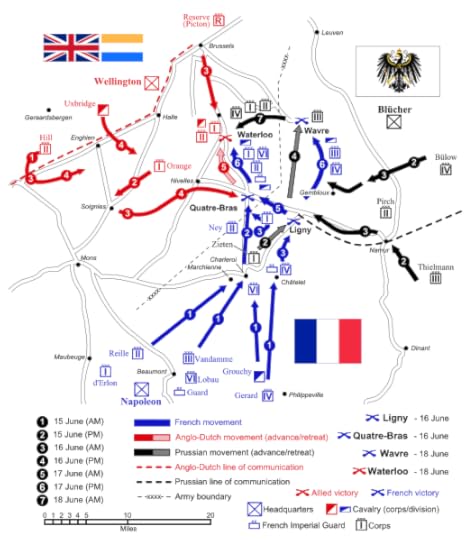
In my other article on the Battle of Quatre Bras I go into more detail on the origins of this battle.
In brief on returning from exile on Elba, Napoloeon had gathered an army of veterans and marched on the combined Anglo Dutch under Wellington and Prussians under Blucher. The allies were positioned in Belgium waiting to attack France. Napoleon did not dance to their tune but attacked them first and drove into the gap between the two allies.
On 16th June, at the cross roads of Quatre Bras, the French under Marshall Ney and Anglo Dutch under Wellington were locked into a stalemate battle – neither side being able to send aid to the main battlefield of the day – Ligny.
At Ligny Napoleon battered the Prussians and forced them to retreat BUT because Ney had not broken through at Quatres Bras had not had enough troops to crush Blucher.
Retreat
On the 17th June Wellington was forced to fall back to the position at Waterloo whilst waiting and hoping that the Prussians would also retreat northwards – keeping in contact and able to aid the British. Blucher did this and as dusk fell on the 17th the scene was set for the battle of Waterloo.
Napoleon was conscious that Blucher might try and rejoin Wellington and send a third of his army under Grouchy to pursue the Prussians with strict instructions NOT to allow that to happen. Blucher left just 1 corps (a quarter of his force) to hold the French at Wavre whilst the other three set off at once towards Waterloo. Their arrival would be critical as we shall see.
The Battle of Waterloo
Hearing that Blucher was marching from the village of Wavre (where the Prussians had reached the night before) Wellington deployed his army on the northern side of a valley near a small Belgium village of Mount St Jean just south of the town of Waterloo.
Wellington was a genius at the defensive battle and had seen that this location was perfect. The ridge itself would hide his men and forward of the slope there were three strongholds. On the his right wing the fortress of Hougoumont. Here he deployed some of his guards companies. Covered by woods to the south (in which he placed light infantry) the Chateaux had tall stone walls and thick gates. In the centre of the position was the fortified farmhouse of La Haye Sainte. To the left were several connected buildings at Papelotte and La Haye.
11am. The French Attack Hougoumont
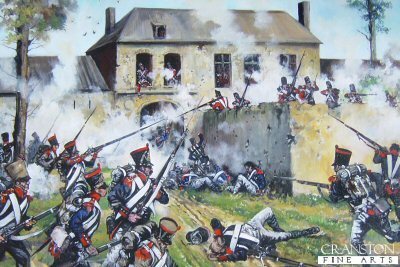
Napoleon opened his attacks by sending Reille's II Corps to assault Hougoumont hoping to draw the British away from their left wing where he had prepared a hammer blow. Intended as a diversion, more and more French forces were drawn into the battle around the fortress which caught fire but never fell.
1pm D'Erlon attacks
Napoleon now sent forward the 16,000 infantry of D'Erlon's I Corps to try and smash through Wellington's left wing. The French attacked in dense columns and the sight must have been terrifying. But the British had seen this before many a time in Spain and calmly stood up in line, levelled muskets and blasted the French Regiments.
2PM: Uxbridge Charges
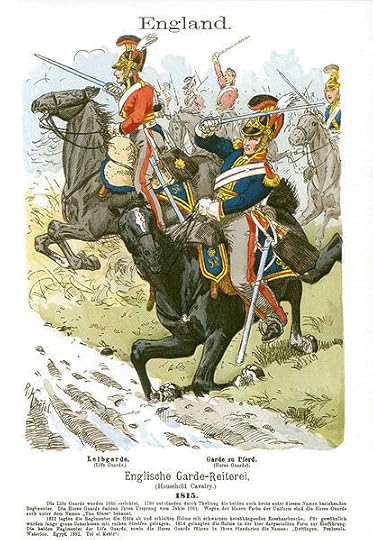
With the French regiments in disarray Wellington committed his heavy cavalry under Uxbridge. Thought to be the finest mounted cavalry in Europe the Heavy cavalry of the Scots Greys and other regiments thundered through the gaps in British regiments and shattered the French. D'Erlon's men ran and the horses pursued. BUT they now made the mistake British cavalry always did: they went too far. With cries of 'Tally-Ho' – as if they were hunting fox in Leicestershire they found themselves winded and far away from the British lines when the French lancers caught them and destroyed them.
4pm Ney leads the French Cavalry forward
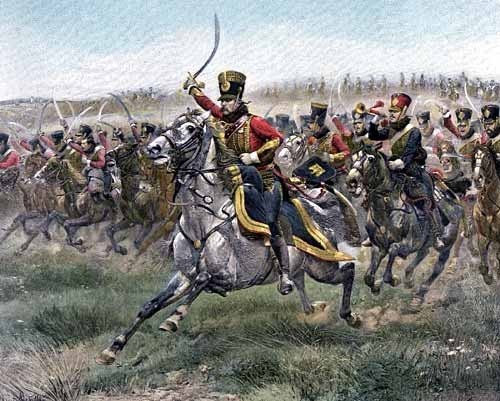
Around 4pm the British, having repelled the French attack reorganised their lines and pulled back over the ridge. Napoleon was at this moment ill (he had a stomach ulcer) and Ney who was in charge saw this movement and thought Wellington was retreating. He ordered the entire French Cavalry reserve to attack at once.
The charge by the French cavalry at Waterloo would have look terrifying and magnificent at the same time. Initially 5000 horses charged bt when they crested the ridge they found the British were NOT retreating but had formed square 0f the defence against cavalry. Scattered like a chess board these squares resisted no less than 12 French charges with as many at 9000 Cavalry at once. The British endured and held on.
4pm The Prussians Arrive
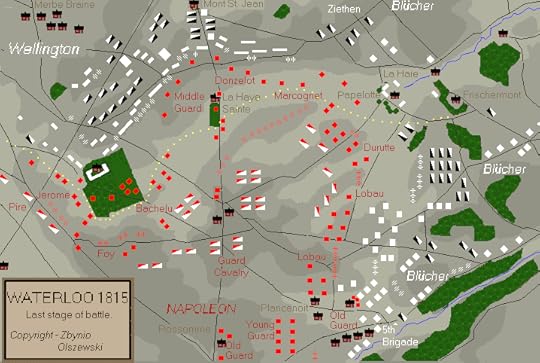
The Prussian's finally started to arrive from about 4pm onwards. Napoleon sent his Guard and a reserve Corps to hold them back. To begin with they defended easily but more and more Prussians arrived and gradually the French fell back into Plancenoit. That town fell and the French used the Young Guard to assault it and recapture it.
Things were getting desparate though. Napoleon knew He HAD to break Wellington NOW or lose the battle.
7pm The Guard Attack – final thrown of the dice.
"Give me night or give me Blucher" – Wellington at Waterloo (There us a dispute about this prayer – maybe he never said it but her certainly felt it)
Napoleon gathered all his resources. he threw forward a heavy attack to take La Haye Sainte. Then vast clouds of skirmishers supported by artillery and cavalry pounded and pulverised the Anglo-Dutch lines who could do little save stand and suffer. Wellington, trusting that the Prussians would fill the hole abandoned Papelotte and concentrated all his men in the centre of the line, he held on and endured.
Now was the time for the thunder strike. Napoleon sent forward his Imperial Guard. Veterans of many battles ato assault the British between La Haye Sainte and Hougoumont. These were the men who had conquered Europe and he needed them to do it one more time. They stomped up the ridge towards the British.
But what was this? the ridge seemed empty. All they could see was a few officers. Was that Wellington up there on his own.
This was victory …this was glory! En Avant. Vive L'Empereur!"
And then one sentence changed everything. One sentence spoken loud and clear by Wellington:
Now Maitland. Now's your time!" One authority had him adding "Up Guards, ready".
As one the British Guard's Regiment under Maitland rose from where they were kneeling in the grass. They levelled their muskets and fired. The best marksmen in the world now fired devastating volley after volley. The Imperial guard – never before defeated – wavered, fell back and RAN.
Defeat
With the Middle Guard streaming back from the ridge and the Prussians surging through Plancenoit again, the French morale cracked and the army started to run. Wellington raised his hat and waved it forward with the words:
"The whole line will advance!"
The Anglo Dutch and Prussians surged forward and the French routed and that was that.
Within an area of 2 miles by 2 miles there were 48,000 bodies – killed and wounded – desperately crying for aid.
It was Wellington's last battle. It was a bloody and costly battle but finally Napoleon was defeated.
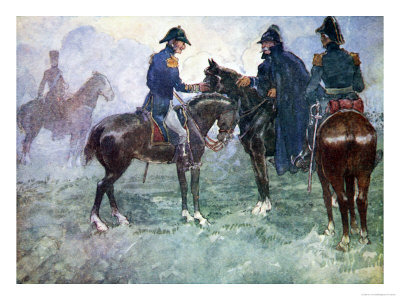
I am Richard Denning. I write historical fiction and Fantasy. Find out more at www.richarddenning.co.uk

June 16, 2011
June 16th 1815 The Battle of Quatre Bras
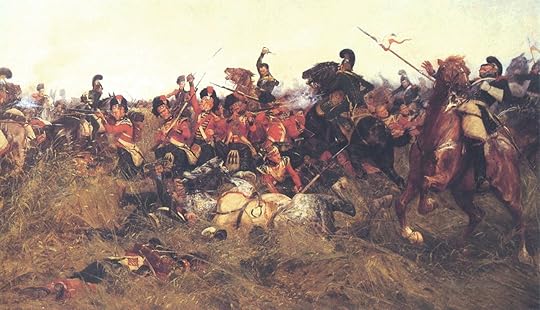
Today is the anniversary of the Battle of Quatre Bras. Never heard of it? Well if I mention a more famous battle that happened 2 days later – The Battle of Waterloo – you maybe now understand the campaign that I am talking about.
Waterloo was the climatic battle in the wars that started shortly after the French revolution and ran on through the 1790s on as far as 1815. From around 1796 onwards they became increasing focused around the ambition of one man: Napoleon Bonaparte.
Napoleon had led a series of Campaigns across Europe and at one point ruled lands from Portugal to Moscow. But of course the disaster of the Russian Invasion in 1812, the unified resistance by Austria, Russia, Prussia as well as thorn in Napoleon's side of Wellington and his campaigns in Spain, led to the Emperor's defeat in 1814. He was sent to Elba in exile.
In 1815 he was back from exile and galvanised the French nation once more under his leadership. The Allies knew they had to do something to prevent Europe being plunged into yet more years of warfare and so began to gather in the Low countries and along the Rhine ready to invade France. This process would take weeks – especially for the more distant Russians to arrive.
Napoleon's Plan
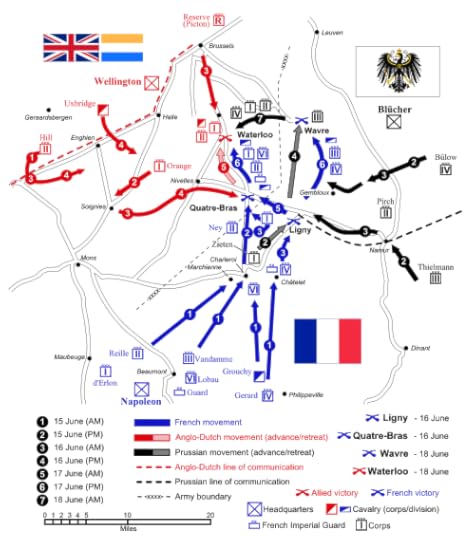
Napoloeon refused to wait for that invasion. In June 1815 he assembled an army of 100,000 veterans of his wars on the Belgium Border at the city of Charleroi and attacked. He had spotted a flaw in the allied deployment. Wellington's Anglo Dutch Army was arranged in the west of Belgium – west of the Charleroi to Brussels road. Blucher's Prussians (Wellington's ally) had his army to the east of that line.
Napoleon realised that if he attacked right down that road – on the line that divided the allies he could cause chaos and confusion. Then he would try and destroy the Prussian army whilst keeping the British at bay. Once Blucher was running for Germany he would turn on Wellington.
So on the 15th June Napoleon attacked up the high road. He took the bulk of the French Army with him towards Ligny where the Prussians were gathering. He sent Marshall Ney to Quatre Bras with orders to capture the poorly defended cross roads, hold off any British counter attack and send the bulk of his force along the road to Ligny to fall upon the flank of the Prussians and crush them. If everything went well Blucher's Prussians would be destroyed before Wellington could react.
That night Wellington was indeed distracted. He had been invited – along with the bulk of the officers to a ball in Brussels. That meant that at the very moment when Napoleon was marching up the road from Charleroi the British were caught entirely off guard. When news reached the ball Wellington was already 18 hours behind the pace of the campaign. He at once sent his officers to gather the men and march on Quatre Bras.

The Battle
At the beginning of the battle Marshall Ney had 18,000 men and 32 guns with 2000 cavalry and faced only 8,000 infantry and 16 guns. These allied troops were Dutch regiments and although they fought well they were forced back towards the cross roads. Fresh British troops started to arrive two hours later as well as Wellington himself who then took command. As the day went on more and more British and allied divisions arrived until at the end of the battle – around 9pm, Wellington with 24,000 men had a numerical superiority over Ney.
In those 6 hours the battle swung back and forth. The French launched a series of attacks – some of which reached the cross roads only to be forced back by a new allied division arriving and counter attacking. One famous moment was the arrival of the Duke of Brunswick and his black uniformed cavalry complete with death's head symbols on their shakos. Their charge repelled the French once again but at the cost of the Duke's life.
Another incident of note was when the Prince of Orange (a young Dutch prince with no battle experience) ordered the British to advance in line even though there were hordes of French cavalry around who promptly charged the British and slaughtered two battalions.
Battle of Ligny
Whilst the battle was raging at Quatre Bras Napoleon had the upper hand at the nearby battle of Ligny. All he needed to complete victory was for Ney to break through at Quatre Bras and send him more troops onto the Prussian Flank. Napoleon even summoned a reserve Army corps under D'erlon to leave Quatre Bras and join him but just as it was arriving at Ligny Ney ordered it back to Quatre Bras. So the French missed the opportunity to use D'erlon at either battlefield as it spent most of the day marching around the Belgium country side. Wellington too was unable to help out at Ligny. Blucher had to face Napoleon alone.
The French beat the Prussians at Ligny and forced them to retreat but they had not crushed them. Never the less because the Prussian's were retreating Wellington was obliged to follow suit and spent the 17th June moving his army back northwards. However because the Prussians were able to retreat in good order, Blucher would be able to bring three Army Corps to help Wellington 2 days later at Waterloo.
So who won at Quatres Bras?
In truth both sides claimed a victory and both sides had lost about 5000 men. Ney should have broken through early in the battle and Wellington was brilliant in defence and held him off but was unable to help Blucher himself. So it was a really a draw.
Quatres Bras and Ligny left unfinished business that would only be resolved 2 days later at a battlefield just south of a small town called Waterloo.
One of my areas of interest is the Napoleonic wars. My historical fiction is set at other time (The Saxon Period and the 17th century) but I find this period fascinating and I have visited all the battlefield of the Hundred Days Campaign and recommend them. Waterloo in particular is ideal for touristis but armed with a map and guide you can find much at Quatres Bras of interest.

June 13, 2011
Alexander the Great dies Jun 13, 323 B.C
Today in the year 323 BC (or possibly on one the the last 2 or 3 days) Alexander the Great died in the palace of Nebuchadnezzar II, in Babylon at the age of 32.
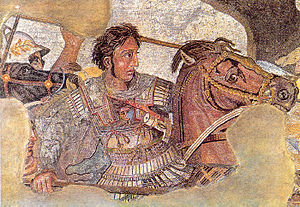
Alexander (356 BC to 323 BC) was the son of King Phillip of Macedon and was educated my non other than the great teacher Aristotle. He first lead a victorious army in battle at the age of 16 and at the age of 20 succeeded to the throne when his father was assassinated.
By 334 BC he had secured the military command and in effect leadership of Greece and now assembled an army. He lead this army on to Persian-ruled Asia Minor. Over the next ten years Alexander first crushed the mightly Persian Empire at the battles of Issus and Gaugamela and defeated the Persian king Darius II. He had conquered Egypt, Persia and gone on to invade Afghanistan.
With no limits to his ambition he strove to reach the "ends of the world and the Great Outer Sea" and so invaded India in 326 BC. FInally though it was not an enemy that foiled his ambition but his own army. After ten long years they were weary and wanted to settled down and live their lives and Alexander, confronted by a near-mutiny of his troops was forced to turn back.
Alexander's death has an element of mystery to it. After a night and a day of feasting and drinking he collapsed and died 2 days later. Was it typhoid fever or was it assassination? Whatever the cause his death plunged his unified empire into civil war as various of his generals vied for power. None would be able to unite his once widespread realm.
Alexander was a charismatic leader who inspired his troops to great things. He was full of driving ambition . BUT he was also a warlord bent on conquest with little thought for those unfortunate to get in his way. Every one must make their own mind up about him. In this modern age he can seem warmongering and bloodthirsty and all peaceloving people will hope that the world would not see his like again.
Yet, like Napoleon and Caesar after him, he shared a burning drive and ambition to keep going and achieve something in their brief mortal lives: to make a mark on history. To me that surely MUST be worth some admiration.
One of the fun parts of writing historical fiction and time travel stories is the ability to encounter these great figures. Alexander features in Tomorrow's Guardian when Tom and his friends get captured by him and again (after his death) in Yesterday's Treasures when Tom and the Hourglass Institute must travel back in time and locate his tomb. I particularly enjoyed researching the facts about his missing tomb around which there is a mystery that perhaps will feature in another blog.



